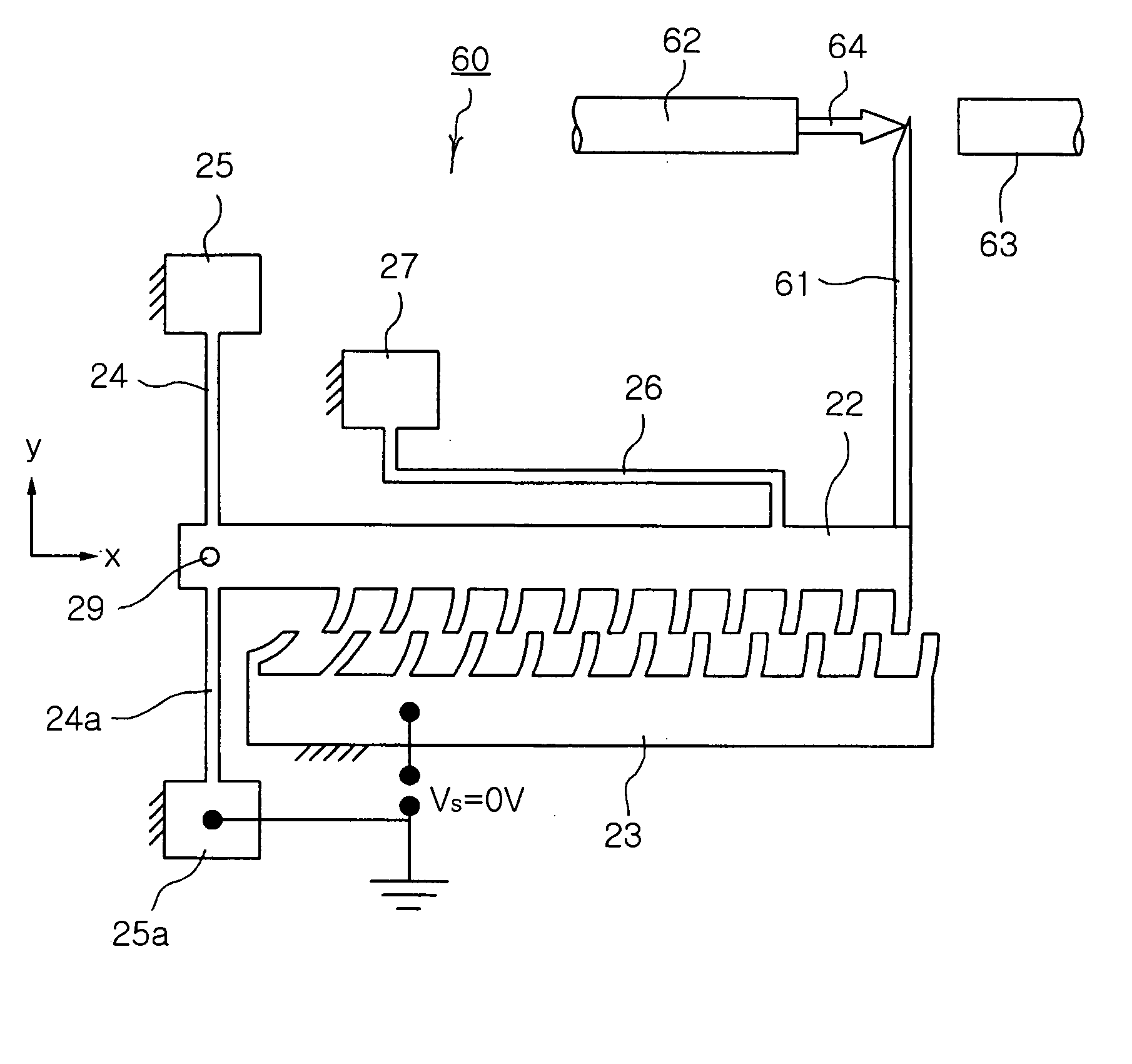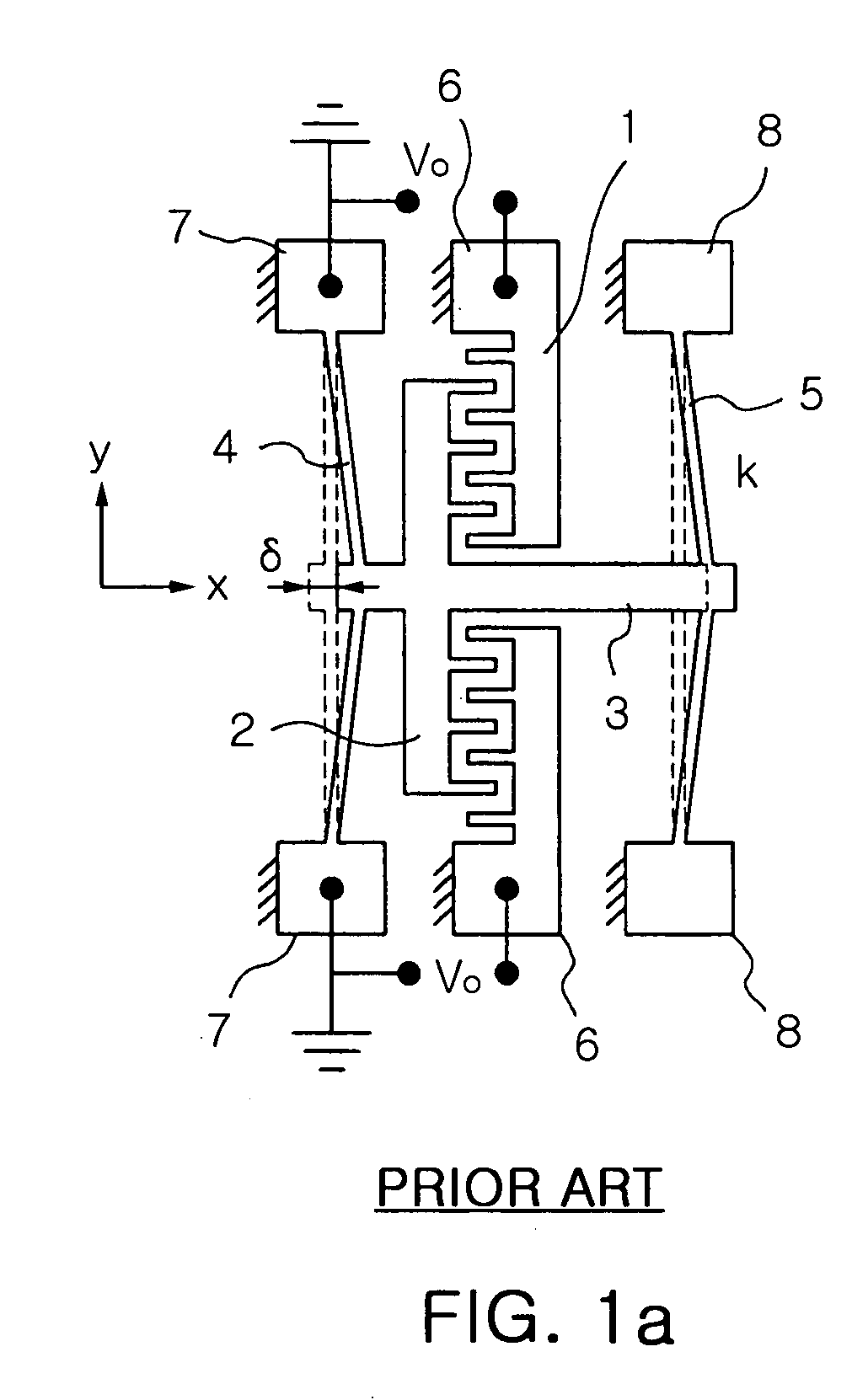Rotary-type comb-drive actuator and variable optical attenuator using the same
a comb-drive actuator and variable technology, applied in the direction of device details, instruments, device details, etc., can solve the problems of increasing the size of elements and the cost of products, products using the actuator, and generating response variations
- Summary
- Abstract
- Description
- Claims
- Application Information
AI Technical Summary
Benefits of technology
Problems solved by technology
Method used
Image
Examples
first embodiment
[0038]FIG. 2 is a perspective view of a rotary-type comb-drive actuator according to the present invention.
[0039] Referring to FIG. 2, a rotary-type comb-drive actuator 20 according to the first embodiment of the present invention includes a silicon substrate 21, a comb-shaped movable electrode 22, a comb-shaped drive electrode 23, vertical and horizontal springs 24, 24a and 26, and anchors 25, 25a and 27 to support the springs 24, 24a and 26, respectively.
[0040] The movable electrode 22 is arranged on the silicon substrate 21 to be movable in parallel to the plane of the substrate 21 while being spaced apart from the substrate 21 by a predetermined distance. Further, the movable electrode 22 is formed lengthwise in a horizontal direction, and has the comb-shaped electrode that is formed thereon and comprised of a plurality of fingers to be driven by an electrostatic force.
[0041] The drive electrode 23 has the comb-shaped electrode that is formed thereon and comprised of a plurali...
second embodiment
[0052]FIG. 4 is a plan view of a rotary-type comb-drive actuator according to the present invention.
[0053] Referring to FIG. 4, a rotary-type comb-drive actuator 40 according to the second embodiment of the present invention further includes an auxiliary horizontal spring 41, which is a beam spring arranged in a horizontal (x axis) direction, and an auxiliary horizontal spring anchor 42. The auxiliary horizontal spring anchor 42 is fixed on the substrate 21 by a silicon oxide film 43.
[0054] The rotary-type comb-drive actuator 40 includes the auxiliary horizontal spring 41 extending along the longitudinal direction of the movable electrode 22 from an end of the movable electrode 22 adjacent to the rotation center 29, and the auxiliary horizontal spring anchor 42 to support the auxiliary horizontal spring 41, thus restricting the movement of the movable electrode 22 in the horizontal (x axis) direction through much higher stiffness.
[0055] Further, in the rotary-type comb-drive actua...
third embodiment
[0056]FIG. 5 is a plan view of a rotary-type comb-drive actuator according to the present invention.
[0057] Referring to FIG. 5, a rotary-type comb-drive actuator 50 according to the third embodiment of the present invention further includes a counter mass 51 on a side opposite to the movable electrode 22 around the rotation center 29. The counter mass 51 has a certain weight to allow the rotation center 29 to be the center of the gravity without being fixed on the substrate 21.
[0058] When the counter mass 51 is formed in the rotary-type comb-drive actuator 50 as in the case of the third embodiment of the present invention, the excitation force of a vibration noise acts on the center of the gravity, that is, the rotation center 29, even when the vibration noise is externally caused in any direction of translational motion, thus eliminating moment generated in the actuator 50 by such excitation. The rotary-type comb-drive actuator 50 having the counter mass 51 can minimize the genera...
PUM
 Login to View More
Login to View More Abstract
Description
Claims
Application Information
 Login to View More
Login to View More - R&D
- Intellectual Property
- Life Sciences
- Materials
- Tech Scout
- Unparalleled Data Quality
- Higher Quality Content
- 60% Fewer Hallucinations
Browse by: Latest US Patents, China's latest patents, Technical Efficacy Thesaurus, Application Domain, Technology Topic, Popular Technical Reports.
© 2025 PatSnap. All rights reserved.Legal|Privacy policy|Modern Slavery Act Transparency Statement|Sitemap|About US| Contact US: help@patsnap.com



